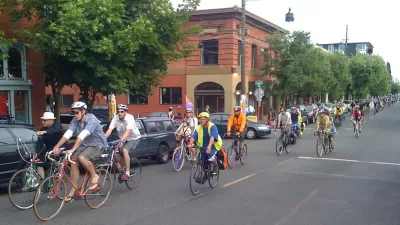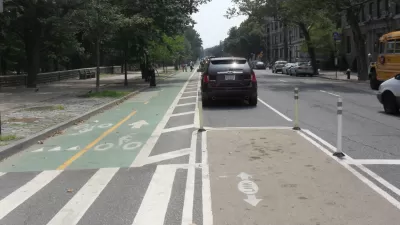In retrospect, it may seem like Portland’s biking boom was inevitable. But not too long ago the city was eclipsed by other Pac NW cities for share of bicycle commuters. What happened between 2002-2008 to kick-start the city’s bike craze?

Between 1990 and 2011, many of the largest cities in North America witnessed an increase in their percentage of bicycle commuters. But none has been more dramatic than the spike seen in Portland, where the mode share increased from 1.1 percent to 6.8 percent over that period. Seattle, for instance, increased from 1.5 percent to 3.7 percent.
“What happened? Why did Portland cycling rates increase so much more than other leading bike cities?” ask Michael Andersen and Jonathan Maus, editors for BikePortland. They cite 2002-2008 as the key years when bicycle commuting took off in the city, and propose five possible factors that contributed to its astonishing rise.
One theory involves the influence of instilling fun in pedaling via events led by groups such as Shift. Others include: the work of City staff “advocrats” pushing forward bicycle-friendly design enhancements; intuitive marketing and outreach approaches; and engaged citizen advocates.
FULL STORY: What caused Portland's biking boom?

Alabama: Trump Terminates Settlements for Black Communities Harmed By Raw Sewage
Trump deemed the landmark civil rights agreement “illegal DEI and environmental justice policy.”

Study: Maui’s Plan to Convert Vacation Rentals to Long-Term Housing Could Cause Nearly $1 Billion Economic Loss
The plan would reduce visitor accommodation by 25% resulting in 1,900 jobs lost.

Planetizen Federal Action Tracker
A weekly monitor of how Trump’s orders and actions are impacting planners and planning in America.

Waymo Gets Permission to Map SF’s Market Street
If allowed to operate on the traffic-restricted street, Waymo’s autonomous taxis would have a leg up over ride-hailing competitors — and counter the city’s efforts to grow bike and pedestrian on the thoroughfare.

Parklet Symposium Highlights the Success of Shared Spaces
Parklets got a boost during the Covid-19 pandemic, when the concept was translated to outdoor dining programs that offered restaurants a lifeline during the shutdown.

Federal Homelessness Agency Places Entire Staff on Leave
The U.S. Interagency Council on Homelessness is the only federal agency dedicated to preventing and ending homelessness.
Urban Design for Planners 1: Software Tools
This six-course series explores essential urban design concepts using open source software and equips planners with the tools they need to participate fully in the urban design process.
Planning for Universal Design
Learn the tools for implementing Universal Design in planning regulations.
Caltrans
Smith Gee Studio
Institute for Housing and Urban Development Studies (IHS)
City of Grandview
Harvard GSD Executive Education
Toledo-Lucas County Plan Commissions
Salt Lake City
NYU Wagner Graduate School of Public Service




























